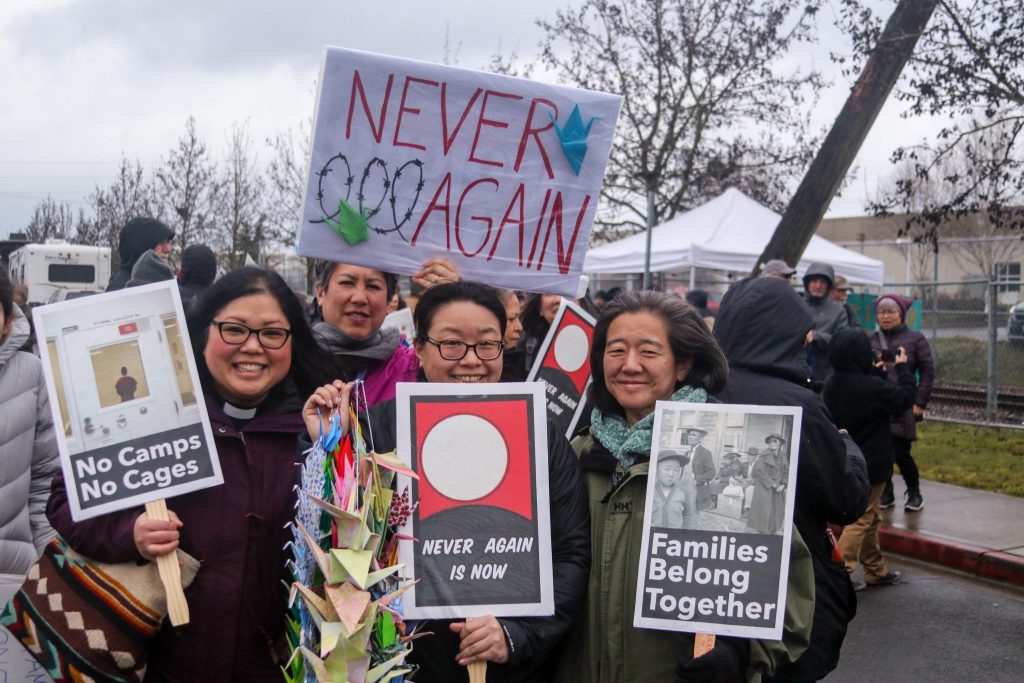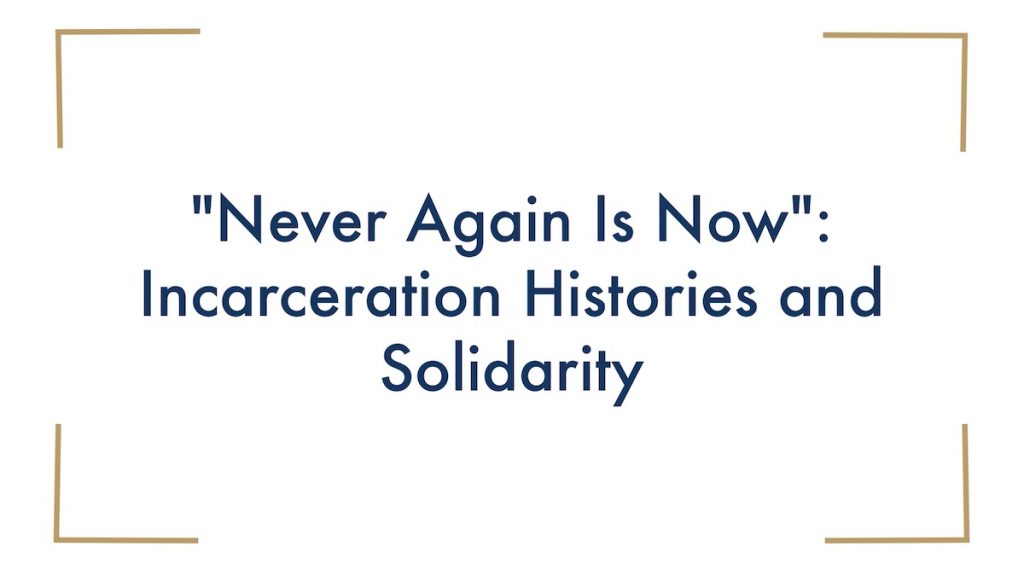In this unit (FREE in Digital Editions), students examine U.S.-Japan relations before World War II, experiences of incarcerated Japanese Americans, and ways the Japanese American community and others in the U.S. have remembered incarceration.
Note: We recommend that this lesson be used in conjunction with one or both of the following Choices Program curriculum units: Japanese American Incarceration in World War II (available for free) and/or Immigration and the U.S. Policy Debate, which provide important context for students. The Choices Program’s interactive timeline U.S. Immigration Policy, Past and Present can also be used to provide important information about U.S. immigration policies. To allow time to complete the activities and have meaningful discussion, we suggest that this lesson be completed over two class periods.
Objectives
Students will:
- Use primary sources to compare and contrast Japanese American incarceration in World War II and contemporary migrant detention;
- Assess the role of xenophobia and racism in these case studies;
- Explore how knowledge of history can inspire activism and build solidarity across communities.
Resources
- Video: Why have there been backlashes against immigrant groups in the United States? (Professor Robert Lee)
- Video: How has race affected the experience of immigrants? (Professor Robert Lee)
- Video: “Never Again Is Now”: Incarceration Histories and Solidarity
- Video: Organizing a Peaceful Protest in Texas—Dr. Satsuki Ina
- Case Study: Japanese American Incarceration
- Case Study: Migrant Detention Today
- Graphic Organizer: Detention Case Studies
- Exploring Motivation: Dr. Satsuki Ina
Note on Remote Teaching
This lesson can be completed in a remote learning environment. We recommend doing a class video session to introduce the activity and discuss reactions to the introductory videos. Student pairs can review their assigned sources and complete the “Graphic Organizer: Detention Case Studies” by using group chat sessions or virtual hangouts. During the jigsaw portion of the lesson, assign students to group chats or breakout rooms to share their case study with other members of the group. Be sure that each case study is represented in the breakout session. Finally, the teacher can lead a virtual class discussion to conclude the lesson after students have completed the jigsaw activity.
Note on Teaching about Immigrant Experiences, Xenophobia, and Racism
Remind students that conversations about these issues will raise issues related to racism and power, which can be emotional. As you discuss these issues with your class, remind students that it is important to be respectful of the experiences of others, to think before they speak, and to be prepared to support their statements with facts.
We encourage teachers to consider carefully the dynamics of their classrooms as they prepare to use these materials. For example, students with different racial or ethnic identities may experience this lesson differently. Students with different political views may offer contrasting perspectives. Discussions can take unexpected turns. Students may unwittingly offend each other. The process of exploring unequal power dynamics can lead students to lash out in anger or to suffer in silence. Teachers need to be aware of these possibilities and act to make their classrooms a safe place for all students. While we cannot offer a formula for dealing with all situations, being prepared for many possible outcomes will go a long way to helping students consider these critical issues. For more resources, see our free lesson on Teaching About Controversial Issues: A Resource Guide.
In the Classroom
1. Set the Stage: Play the video Why have there been backlashes against immigrant groups in the United States? What does Professor Lee think some of the causes of backlash against immigrants are? What does he mean when he says, “It’s easy for politicians to shift the blame to the outsider”?
Play the video How has race affected the experience of immigrants? Ask students to explain in their own words how the first U.S. citizenship laws were both inclusive and exclusive.
2. Review Key Ideas and Concepts: Write the question “What is xenophobia?” on the board. Give students a minute to suggest answers and then provide the following definition:
“Xenophobia is deeply rooted prejudice and suspicion of foreign cultures, religions, and ethnic groups.” Can students identify historical and/or current examples of xenophobia?
Write the question “What is racism?” on the board. Give students a minute to suggest answers and then provide the following definition:
“Racism is more than an individual’s prejudice or bigotry. Racism is a system of social structures (laws, policies, practices, and attitudes) that provides or denies power, resources, opportunities, and safety based on racial categories. This system creates inequities across society.”
Ask students to explain in their own words what “racism is more than an individual’s prejudice or bigotry” means. Challenge them to use examples to illustrate their explanation.
3. Analyze Sources: Tell students that they are going to examine two case studies about the detention of Japanese Americans during World War II and the detention of migrants today. Have students pair up, and assign each pair one of the two case studies. Tell students that they will be responsible for understanding their sources and sharing their case study with classmates who did not read the same one. Distribute the Graphic Organizer: Detention Case Studies to each student. In pairs, students should follow the instructions and complete their assigned case study on the graphic organizer.
Note: An Interactive Timeline: U.S. Immigration Policy, Past and Present provides additional examples and details of U.S. immigration policy throughout history. You might choose to use it to supplement the brief examples given in each case study.
4. Jigsaw: Once the pairs have completed their case studies, form new groups of four (or eight) students. Make sure that both case studies are represented in each group. Within these groups, have students take turns sharing information from their case study. Students should record information about each case study as it is presented on the graphic organizer. After both case studies are presented, groups should discuss similarities and differences they notice across the two case studies. Have each student record key ideas that come out of their conversation.
5. Discuss Findings: Reconvene the whole class. Ask students to share their findings. What were some of the similarities they discovered between the two case studies? What were some of the important differences? In his video, Professor Lee spoke about “…politicians shifting blame to outsiders.” Were there examples of that in the case study sources? Was there a difference in how ideas about race were expressed in the sources in the two case studies? Why do students think that might be?
6. Connect the Past and Present: Write the phrase “Never Again” on the board. Ask students if they have heard the phrase before. What historical event(s) is it associated with? What is the significance of the phrase?
Tell students that they are going to watch a short video about the work of a group called Tsuru for Solidarity. Tsuru is the Japanese word meaning crane, a type of bird. The crane symbolizes peace, compassion, hope, and healing. The group uses Japanese origami (paper folding) of cranes as part of their activism.
Watch the short video “Never Again Is Now”: Incarceration Histories and Solidarity. As students watch, have them write down key phrases or ideas that they notice. Invite students to respond to the video. What are activists protesting? Who is protesting? How does Tsuru for Solidarity use the origami cranes in the protests? Why do members of Tsuru say they are protesting?
Based on what they saw in the video, ask students to explain the meaning of the word solidarity. Why do they believe that the group calls itself Tsuru for Solidarity? (If necessary, provide the following definition: “Solidarity is mutual support, unity, or agreement of feeling or action, especially among individuals with a common interest. Solidarity is usually associated with the work of activists, people who work to bring about social and political change.”) What group of people is Tsuru expressing solidarity with?
What do students think Dr. Satuski Ina means when she says, “We are saying, ‘Stop repeating history’”? What history is she referring to? What does this imply about the relationship between the past and the present?
Extra Challenge
1. Understanding Personal Motivation
Tell students they are going to watch Dr. Satsuki Ina describe her motivations for helping to found “Tsuru for Solidarity,” the Japanese American activist organization working to stop family separation and immigrant detention in the United States today.
Distribute Exploring Motivation: Dr. Satsuki Ina to all students. Have students watch the video Organizing a Peaceful Protest in Texas two times and answer the questions on the worksheet. After playing it once through, replay and pause at the quotations highlighted on the student worksheet. (The video timecode for each quotation is listed on the worksheet.) Give students a chance to respond to each quotation on the handout, using their own words to restate what they think each statement means. Review student responses together as a class and clarify concepts as necessary.
2. Exploratory Writing: What is moral authority?
At 1:21 of the video Organizing a Peaceful Protest in Texas, Dr. Satsuki Ina says, “As Japanese Americans, we have the moral authority to protest.” Have students write a short essay in which they explore the question “What does it mean to have moral authority?” Teachers can choose to provide the following prompts for students who might need them: What is moral authority? How is it gained? Can people disagree over who has it? How does having moral authority benefit social activism or protest? Is moral authority necessary for social activism or protest? Students should write in the third person and use examples and evidence to support their assertions.
Thank you to Erin Aoyama for her work creating and writing this lesson.
 Photo by Ryan Kozu.
Photo by Ryan Kozu.
Banner image: Satsuki Ina (second from right). Photo courtesy of Tsuru for Solidarity.


